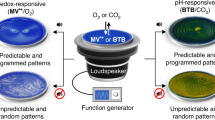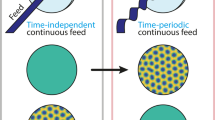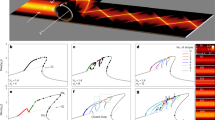Abstract
A periodic force applied to a nonlinear pendulum can cause the pendulum to become entrained at a frequency that is rationally related to the applied frequency, a phenomenon known as frequency-locking1. A recent theoretical analysis showed that anarray of coupled nonlinear oscillators can exhibit spatial reorganization when subjected to external periodic forcing2. We present here experimental evidence that reaction–diffusion processes, which govern pattern evolution and selection in many chemical and biological systems3, can also exhibit frequency-locking phenomena. For example, periodic optical forcing of the light-sensitive Belousov–Zhabotinsky (BZ) reaction transforms a rotating spiral wave4 to a labyrinthine standing-wave pattern (Fig. 1). As the forcing frequency is varied, we observe a sequence of frequency-locked regimes, analogous to the frequency-locked ‘tongues’ of a driven nonlinear pendulum, except that in the reactor different frequencies correspond to different spatial patterns. Resonant interactions leading to standing-wave patternshave not been observed previously in chemical or biological media, but periodic forcing (such as circadian rhythm) is abundant in nature and may lead to similar pattern-forming phenomena.

The reaction occurs in a 0.4-mm-thick porous membrane disk that is placed between two reservoirs (I and II) which are continously refreshed with BZ reagents. The region shown is a 13 × 13 mm section of the 25-mm-diameter reactor. The patterns in the membrane are determined from light absorption measurements at 450 nm. In the perturbed region, light of 0.2 W m−2intensity in the spectral range 430–470 nm is periodically switched on for 6 s and then off for 13 s. Spatially uniform illumination is achieved using a video projector (Sanyo PLC-220N) calibrated by measuring light reflected from a scatter plate and then adjusting each pixel to have the same intensity. The concentrations of thechemicals in reservoirs I and II are: [malonic acid]I = 0.22 M, [BrO3−]I = 0.046 M, [BrI−] = 0.2 M, [H2SO4]I = 0.8 M, [Ru(bpy)32+]II = 1.0 mM, [H2SO4]II = 0.8 M, [BrO3−]II = 0.184 M (here bpy indicates 2,2′-bipyridine). The volume of each reservoir is 10 ml. The flow rate in reservoir I is 20 ml h−1; in reservoir II, 5 ml h−1. The system is maintained at a temperature of 23 °C.
This is a preview of subscription content, access via your institution
Access options
Subscribe to this journal
Receive 51 print issues and online access
$199.00 per year
only $3.90 per issue
Buy this article
- Purchase on Springer Link
- Instant access to full article PDF
Prices may be subject to local taxes which are calculated during checkout


Similar content being viewed by others
References
Thompson, J. M. T. & Stewart, H. B. Nonlinear Dynamics and Chaos (Wiley, Chichester, 1986).
Coullet, P. & Emilsson, K. Strong resonances of spatially distributed oscillators: a laboratory to study patterns and defects. Physica D 61, 119–131 (1992).
Murray, J. D. Mathematical Biology (Springer, Berlin, 1989).
Winfree, A. T. Spiral waves of chemical activity. Science 175, 634–636 (1972).
Gaspar, V., Bazsa, G. & Beck, M. T. The influence of visible light on the Belousov-Zhabotinskii oscillating reactions applying different catalysts. Z. Phys. Chem. (Leipzig) 264, 43–48 (1983).
Kuhnert, L. Anew optical photochemical memory device in a light-sensitive chemical active medium. Nature 319, 393–394 (1986).
Ouyang, Q. & Swinney, H. L. Transition to chemical turbulence. Chaos 1, 411–420 (1991).
Krinsky, V. I. & Agladze, K. I. Interaction of rotating waves in an active chemical medium. Physica D 8, 50–56 (1983).
Steinbock, O., Zykov, V. & Müller, S. Control of spiral-wave dynamics in active media by periodic modulation of excitability. Nature 366, 322–324 (1993).
Hagberg, A. & Meron, E. Complex patterns in reaction-diffusion systems: A tale of two front instabilities. Chaos 4, 477–484 (1994).
Kapral, R., Livi, R., Oppo, G-L. & Politi, A. Dynamics of complex interfaces. Phys. Rev. E 49, 2009–2022 (1994).
Lee, K. J., McCormick, W. D., Ouyang, Q. & Swinney, H. L. Pattern formation by interacting chemical fronts. Science 261, 192–194 (1993).
Bennett, C. H., Grinstein, G., He, Y., Jayaprakash, C. & Mukamel, D. Stability of temporally periodic states of classical many-body systems. Phys. Rev. A 41, 1932–1935 (1990).
Rehberg, I., Rasenat, S., Fineberg, J., de la Torre Juarez, M. & Steinberg, V. Temporal modulation of travelling waves. Phys. Rev. Lett 61, 2449–2452 (1988).
Walgraef, D. Spatio-Temporal Pattern Formation (Springer, New York, 1997).
Winfree, A. T. Scroll-shaped waves of chemical activity in three dimensions. Science 181, 937–939 (1973).
Acknowledgements
We thank A. Lee for discussions and G. Li for help in conducting the experiments. This work was supported by the US Department of Energy Office of Basic Energy Sciences and the Robert A. Welch Foundation.
Author information
Authors and Affiliations
Corresponding author
Rights and permissions
About this article
Cite this article
Petrov, V., Ouyang, Q. & Swinney, H. Resonant pattern formation in achemical system. Nature 388, 655–657 (1997). https://doi.org/10.1038/41732
Received:
Accepted:
Issue Date:
DOI: https://doi.org/10.1038/41732
This article is cited by
-
Predator–prey pattern formation driven by population diffusion based on Moore neighborhood structure
Advances in Difference Equations (2019)
-
Gain through losses in nonlinear optics
Light: Science & Applications (2018)
-
Mode-locking via dissipative Faraday instability
Nature Communications (2016)
-
Prediction of nested complementary pattern in argon dielectric-barrier discharge at atmospheric pressure
Scientific Reports (2015)
Comments
By submitting a comment you agree to abide by our Terms and Community Guidelines. If you find something abusive or that does not comply with our terms or guidelines please flag it as inappropriate.



